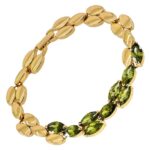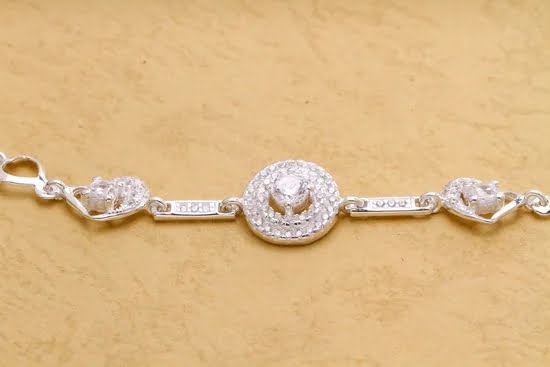When it comes to running a successful fashion jewelry business, pricing plays a crucial role. Finding the right price for your products not only maximizes your profits but also attracts customers. However, pricing fashion jewelry can be a challenging task that requires careful consideration of various factors. In this article, we will explore why pricing fashion jewelry is important and delve into the challenges and considerations involved.
Setting the right price for fashion jewelry is essential for any business looking to thrive in the competitive market. A well-priced product can make all the difference in attracting customers and generating sales. Additionally, pricing influences perceptions of value and quality among consumers. Therefore, it is vital to strike a balance between profit margins and affordability in order to capture your target audience.
However, determining the optimal price for fashion jewelry involves more than simply guessing or arbitrarily choosing numbers. It requires careful analysis and understanding of cost factors involved in production, market research, target audience preferences, perceived value, pricing strategies, and evaluation techniques. By gaining insights into these aspects and applying effective pricing methods, you can position your fashion jewelry brand for success.
In the following sections of this article, we will explore each of these topics in detail. Understanding cost factors helps ensure that you are accounting for all expenses incurred in making your products. Market research enables you to anticipate customer expectations and analyze competitor prices effectively.
Evaluating different pricing models helps you choose one that aligns with your business objectives. Assessing perceived value allows you to enhance customer perception of your brand’s worth. Finally, testing and analyzing pricing strategies along with making necessary adjustments ensures long-term profitability.
Overall, mastering the art of pricing fashion jewelry requires a comprehensive approach that considers various elements at play in the market landscape. By implementing effective strategies tailored to your brand’s unique offerings and target market, you can set prices that attract customers while maximizing profitability. So let us take a closer look at each of these factors and equip you with the knowledge to confidently price your fashion jewelry for success.
Understanding the Cost Factors in Fashion Jewelry Pricing
When pricing fashion jewelry, it is crucial to have a clear understanding of the cost factors involved in the production process. This knowledge will enable you to set prices that cover all expenses while still allowing for profit. Here are some important cost elements to consider when pricing fashion jewelry:
- Materials: The type and quality of materials used in creating fashion jewelry greatly impact its overall cost. Precious metals like gold and silver tend to be more expensive, while base metals like brass or stainless steel are more affordable options. Similarly, gemstones and crystals vary widely in price depending on their quality and rarity.
- Labor Costs: The amount of time and skill required to craft each piece of fashion jewelry plays a significant role in determining its price. Handmade pieces may require higher labor costs compared to mass-produced ones.
- Overhead Expenses: Overhead expenses include rent for the workspace, utilities, insurance, equipment maintenance, and other overhead costs associated with running a fashion jewelry business. It’s important to include a proportional share of these expenses in the final product price.
- Packaging: The presentation of fashion jewelry can greatly influence its perceived value by customers. High-end packaging such as branded boxes or velvet pouches may increase the overall cost per item.
To accurately calculate the cost factors mentioned above, it is essential to keep detailed records of all expenses related to materials, labor, overheads, and packaging. By doing so, you can determine the total manufacturing cost per unit and use this as a basis for setting competitive prices that cover all expenses while ensuring profitability.
Factors Influencing Fashion Jewelry Pricing
Although determining costs is vital when pricing fashion jewelry, it is also important to consider external factors that influence pricing decisions:
- Market Demand: Understanding market demand is crucial for setting prices that both attract customers and generate profits. If there is high demand for your fashion jewelry designs or if they are unique and difficult to replicate, you may be able to set higher prices. On the other hand, if the market is saturated with similar designs or if demand is low, you may need to adjust your pricing strategy accordingly.
- Brand Positioning: Your brand positioning and perceived value play a significant role in pricing decisions. If your brand is known for its exclusivity, quality craftsmanship, or unique design aesthetics, you can justify higher prices compared to brands that are positioned as more affordable or accessible.
- Competitive Analysis: Analyzing your competitors’ pricing strategies is essential to gain insights into the market dynamics and ensure that your prices are competitive without sacrificing profitability. Consider factors such as their target audience, product quality, and any unique selling points they offer.
By understanding these cost factors and external influences on fashion jewelry pricing decisions, you can establish a solid foundation for setting prices that are both attractive to customers and profitable for your business. Remember to regularly analyze and adjust your pricing strategy as market conditions change to maintain long-term profitability.
Market Research
Market research plays a crucial role in pricing fashion jewelry as it provides valuable insights about competitors and target audience preferences. By conducting thorough market research, fashion jewelry businesses can gain a competitive edge and make informed pricing decisions.
When analyzing competitors, it is essential to identify brands that offer similar products and cater to the same target market. Start by researching their price ranges, product quality, and unique selling points. This information will help determine where your fashion jewelry brand stands in comparison and guide pricing decisions accordingly.
Understanding the target audience is equally important as it helps tailor the pricing strategy to meet their expectations. Conduct surveys or interviews to gather information about their preferences, buying habits, and price sensitivity. Additionally, analyze demographic data to identify trends and patterns that can influence pricing decisions.
To organize market research findings effectively, consider using ordered or unordered lists:
- List of competing fashion jewelry brands along with their price ranges.
- Key features or qualities that differentiate your brand from competitors.
- Summary of survey responses highlighting customer preferences and price sensitivity.
- Demographic data on target audience including age group, gender, location etc.
By investing time in comprehensive market research, fashion jewelry businesses can gain a deep understanding of the competitive landscape and insight into customer behavior. These insights can then be used to inform pricing strategies that align with customer expectations while maximizing profits.
Setting Profit Margin Goals and Pricing Strategy
When pricing fashion jewelry, it is crucial to set profit margin goals and develop a pricing strategy that aligns with the brand’s positioning and target market. Profit margin goals determine the level of profitability a business aims to achieve, while the pricing strategy outlines how the prices will be set to accomplish those goals.
To begin, businesses need to define their desired profit margin in the fashion jewelry industry. This involves considering factors such as production costs, overhead expenses, desired return on investment, and market competition. It is essential to strike a balance between generating sufficient profits and remaining competitive in the market.
Once the profit margin goals are established, businesses can then proceed to develop a pricing strategy. A pricing strategy ensures that prices are set strategically in line with the brand’s positioning and target market preferences. For example, luxury fashion jewelry brands may adopt a premium pricing strategy to position themselves as high-end and exclusive. On the other hand, affordable fashion jewelry brands may opt for a value-based or competitive pricing strategy to appeal to price-conscious customers.
In addition, businesses should also take into account external factors such as market demand and price sensitivity of their target audience. Conducting thorough market research helps gain insights on competitor pricing strategies and enables businesses to identify gaps and opportunities in the market.
Overall, setting profit margin goals and developing a pricing strategy are essential steps in effectively pricing fashion jewelry. By considering cost factors, target audience preferences, market competition, and brand positioning, businesses can maximize profitability while meeting customer expectations.
Pricing Models
Understanding Cost-Plus Pricing
Cost-plus pricing is a popular pricing model used by many businesses, including fashion jewelry brands. This approach involves calculating the total cost of producing a product and then adding a markup to determine the final selling price. The markup is typically expressed as a percentage of the production cost.
In the context of fashion jewelry, the production cost includes various factors such as materials, labor costs, overhead expenses, and packaging. It is important for jewelry designers and manufacturers to accurately calculate these costs to ensure that their prices cover all expenses and allow for a reasonable profit margin.
Evaluating Value-Based Pricing
While cost-plus pricing provides a straightforward method for determining prices, value-based pricing takes into account the perceived value of a product in the eyes of the customer. Instead of solely focusing on production costs, value-based pricing considers what customers are willing to pay based on their perception of the product’s quality, uniqueness, and desirability.
Value-based pricing requires an understanding of the target market and their preferences. By aligning with customer perceptions and expectations, fashion jewelry brands can set prices that reflect the perceived value they offer. This approach allows businesses to capture additional profit margins by leveraging their brand image and reputation.
Choosing the Right Model for Fashion Jewelry
When deciding between cost-plus pricing and value-based pricing for fashion jewelry, it is important to consider several factors. Cost-plus pricing may be more suitable when there is intense competition in price-sensitive markets or when transparency in price calculation is necessary. On the other hand, value-based pricing may be more effective in markets where customers prioritize style, aesthetics, or brand appeal over price.
Ultimately, selecting the right model requires careful analysis of market demand, competitor positioning, target audience preferences, and desired profit margins. It is also worth exploring hybrid approaches that blend aspects of both models to optimize profitability while maintaining customer satisfaction.
By understanding and carefully evaluating these pricing models, fashion jewelry businesses can make informed decisions that help them achieve their financial goals while also meeting customer expectations.
Assessing the Perceived Value of Fashion Jewelry
When it comes to pricing fashion jewelry, one important factor to consider is the perceived value of the product. Perceived value refers to how customers perceive the worth of a product based on factors such as quality, design, brand reputation, and customer experience. Understanding the concept of perceived value and its impact on pricing decisions can greatly influence the success of a fashion jewelry business.
To enhance the perceived value of fashion jewelry, branding and marketing play crucial roles. Building a strong brand image that resonates with the target audience helps create an association of high quality and desirability. This can be achieved through consistent messaging, attractive packaging, and effective storytelling about the inspiration behind each piece.
In addition to branding efforts, marketing strategies also contribute significantly to enhancing perceived value. Utilizing social media platforms and influencers to showcase fashion jewelry in aspirational lifestyles creates a sense of exclusivity and desire among consumers. Collaborations with other brands or influential personalities can also boost perceived value through association.
By continually assessing and monitoring the perceived value of their products, fashion jewelry businesses can make necessary adjustments to pricing strategies. Regularly seeking customer feedback can provide valuable insights into areas where improvements can be made or if price adjustments are warranted. Monitoring market trends also helps ensure that prices remain competitive while maintaining profitability.
Overall, by understanding how customers perceive the value of fashion jewelry and actively working towards enhancing that perception through branding, marketing, and adjusting pricing strategies accordingly, businesses can maximize their profits and create long-term success in this competitive industry.
Pricing Techniques
Discounting, bundling, and limited editions are effective pricing techniques that can be used to attract customers and boost sales in the fashion jewelry business. These strategies offer unique value propositions to consumers, creating a sense of urgency and exclusivity. By implementing these techniques strategically, fashion jewelry businesses can effectively differentiate themselves from competitors and drive customer engagement.
Discounting
One common pricing technique used in the fashion jewelry industry is discounting. Offering discounts allows businesses to create a perception of value for customers while maintaining profitability. There are different approaches to discounting, such as percentage-based discounts, seasonal sales, or clearance events.
It is essential to carefully consider the impact on profit margins before implementing discounting strategies. Businesses should assess their cost structure and set clear objectives for discount campaigns to ensure they do not negatively impact long-term profitability.
Bundling
Another effective pricing technique for fashion jewelry is bundling. Bundling involves combining multiple products or services together and offering them at a discounted price compared to purchasing each item separately. This strategy not only encourages customers to purchase multiple items but also increases the overall perceived value of the bundle. When implementing bundling techniques, businesses should consider selecting complementary products or creating themed bundles that align with customer preferences.
Limited Editions
Limited edition collections are highly sought after by consumers due to their exclusivity and unique designs. By offering limited edition pieces, fashion jewelry businesses can create a sense of scarcity and increased perceived value among customers. Limited editions can be created by deploying various strategies such as partnering with influencers or collaborating with other brands to create co-branded collections.
Additionally, setting a time limit or quantity per customer can further enhance the exclusivity factor. However, it is crucial for businesses to strike a balance between producing enough units for demand without compromising scarcity.
Implementing these pricing techniques should be approached strategically and aligned with the brand’s overall positioning and target market. By carefully considering the impact on profitability, businesses can leverage discounting, bundling, and limited editions to attract customers, increase sales, and create brand loyalty in the competitive fashion jewelry market.
Testing and Analyzing Pricing Strategies
In the competitive world of fashion jewelry, it is crucial for businesses to continuously test and analyze their pricing strategies. This allows them to evaluate the effectiveness of different approaches and make data-driven decisions to maximize profits and attract customers. Implementing A/B testing is a valuable technique that can provide insights into consumer behavior and preferences when it comes to pricing.
A/B testing involves creating two or more variations of a pricing strategy and randomly assigning different groups of customers to each variation. By comparing the performance of these different variations, businesses can determine which pricing strategy resonates better with their target audience. Key metrics such as conversion rates, average order value, and customer feedback can be used to analyze the results and measure the impact of each strategy.
For example, a fashion jewelry business could test two pricing variations: one with a higher price point but with a limited edition tagline, and another with a lower price point but without any special labels. By tracking how many customers purchase each variation, as well as their average order values, the business can assess whether consumers are more attracted by exclusivity or affordability.
| Metrics | Variation A (Limited Edition) | Variation B (Affordable) |
|---|---|---|
| Conversion Rate | 10% | 15% |
| Average Order Value | $50 | $30 |
Based on the hypothetical results above, Variation B has a higher conversion rate and Variation A has a higher average order value. This suggests that affordability may be more important to the target audience than exclusivity alone. The business can then adjust its pricing strategy accordingly, offering a balance between affordability and perceived value to maximize sales.
It is important to continuously test and analyze pricing strategies as consumer preferences and market dynamics can change over time. By staying informed about market trends and regularly evaluating pricing strategies, fashion jewelry businesses can make necessary adjustments to maintain profitability and effectively meet the demands of their target audience.
Pricing Adjustments and Long-Term Evaluation
Adjusting the price of fashion jewelry and regularly evaluating pricing strategies is crucial for maintaining profitability in the long term. In this section, we will discuss the importance of pricing adjustments and provide tips for effectively monitoring market trends and adjusting prices accordingly.
To begin with, it is essential to recognize that the fashion industry is constantly evolving, and consumer preferences can change rapidly. By regularly reviewing pricing strategies, jewelry businesses can stay attuned to market trends and ensure their prices remain competitive. This involves monitoring competitors’ pricing strategies and identifying any shifts in consumer demand or purchasing power.
One effective way to evaluate pricing strategies is through A/B testing. This method involves comparing two different pricing approaches within a specific segment of the target audience to measure their impact on key metrics such as conversion rates and average order value. Conducting A/B tests allows fashion jewelry businesses to make data-driven decisions about their pricing strategies, helping them identify which approaches are most effective in attracting customers and maximizing profits.
In addition to quantitative data analysis, it is also important to gather qualitative feedback from customers. Customer feedback can provide valuable insights into how they perceive the value of the jewelry and whether they believe it is appropriately priced. Feedback can be obtained through surveys or focus groups, allowing businesses to understand how customers perceive their pricing strategy and make necessary adjustments based on their preferences.
Conclusion
In conclusion, pricing fashion jewelry is a crucial aspect that can make or break a business. It is important to find the right price point to maximize profits and attract customers. Throughout this article, we have explored the challenges and considerations involved in pricing fashion jewelry.
Understanding the cost factors in fashion jewelry pricing is essential. From materials to labor costs, overhead expenses, and packaging, each element contributes to the overall cost of production. By analyzing these factors, businesses can determine their base cost and set profit margin goals accordingly.
Market research plays a significant role in determining the pricing strategy for fashion jewelry. By analyzing competitors and identifying the target audience’s preferences and price sensitivity, businesses can gain insights that will help them establish competitive prices while still appealing to their target market.
Setting profit margin goals and developing an appropriate pricing strategy aligns with the brand’s positioning and target market. Businesses need to define their desired profit margin and then choose a pricing model that suits their market dynamics best. Whether it is cost-plus pricing or value-based pricing, understanding the pros and cons of each approach is essential for success.
Furthermore, assessing the perceived value of fashion jewelry through branding and marketing techniques is crucial in today’s competitive market. By enhancing perceived value, businesses can justify higher price points for their products.
Different pricing techniques such as discounting, bundling, and limited editions can also be employed to attract customers and boost sales. These strategies create a sense of exclusivity or urgency that encourages customers to make a purchase.
Testing and analyzing different pricing strategies are important for long-term success. A/B testing allows businesses to evaluate which strategies work best for them based on key metrics like conversion rates, average order value, and customer feedback.
Lastly, businesses should regularly review their pricing strategies to ensure they stay aligned with market trends while maintaining profitability. Market conditions change over time, so adjusting prices accordingly is necessary for sustained success.
In summary, mastering the art of pricing fashion jewelry requires careful consideration of cost factors, market research, defining profit margin goals, choosing the right pricing model, and enhancing perceived value. By implementing these strategies and techniques, businesses can effectively price their fashion jewelry to thrive in a competitive industry.
Frequently Asked Questions
How do I find out how much my jewelry is worth?
Finding out the value of your jewelry can be done through a few different methods. Firstly, you can consult with a professional appraiser who specializes in jewelry. They will evaluate factors such as the materials used, craftsmanship, brand, and any gemstones or precious metals present to determine an accurate value.
Additionally, you can research similar pieces of jewelry online or visit local jewelry stores to get an estimate of how much similar items are being sold for. It’s important to note that sentimental value may not always align with monetary worth, so it’s wise to consider both aspects when determining the value of your jewelry.
How much should I charge for custom jewelry?
Pricing custom jewelry can be challenging since various factors need to be considered. First and foremost, you should evaluate the cost of materials used in creating the piece, including gemstones, metals, and any additional decorations or components necessary. Calculate the labor costs based on the time spent on designing and crafting the custom piece.
Additionally, consider market demand for such unique creations and factors like your experience level and reputation as a jeweler when determining pricing. Comparing prices of similarly customized pieces by other jewelers can also offer valuable insights into appropriate pricing ranges for your own work.
How to price wholesale jewelry for retail?
Pricing wholesale jewelry for retail requires careful consideration to ensure profitability while remaining competitive in the market. Begin by calculating all production costs associated with creating each individual piece of jewelry, including materials, labor costs per unit or batch production, overhead expenses, packaging costs, and shipping expenses if applicable.
Once these costs are determined, add an appropriate profit margin that takes into account your desired return on investment as well as industry standards and customer expectations regarding price points for similar products. Keep in mind that establishing strong relationships with suppliers and negotiating favorable terms can help optimize pricing strategies for wholesale jewelry intended for retail purposes.

Welcome to my jewelry blog! My name is Sarah and I am the owner of this blog.
I love making jewelry and sharing my creations with others.
So whether you’re someone who loves wearing jewelry yourself or simply enjoys learning about it, be sure to check out my blog for insightful posts on everything related to this exciting topic!





